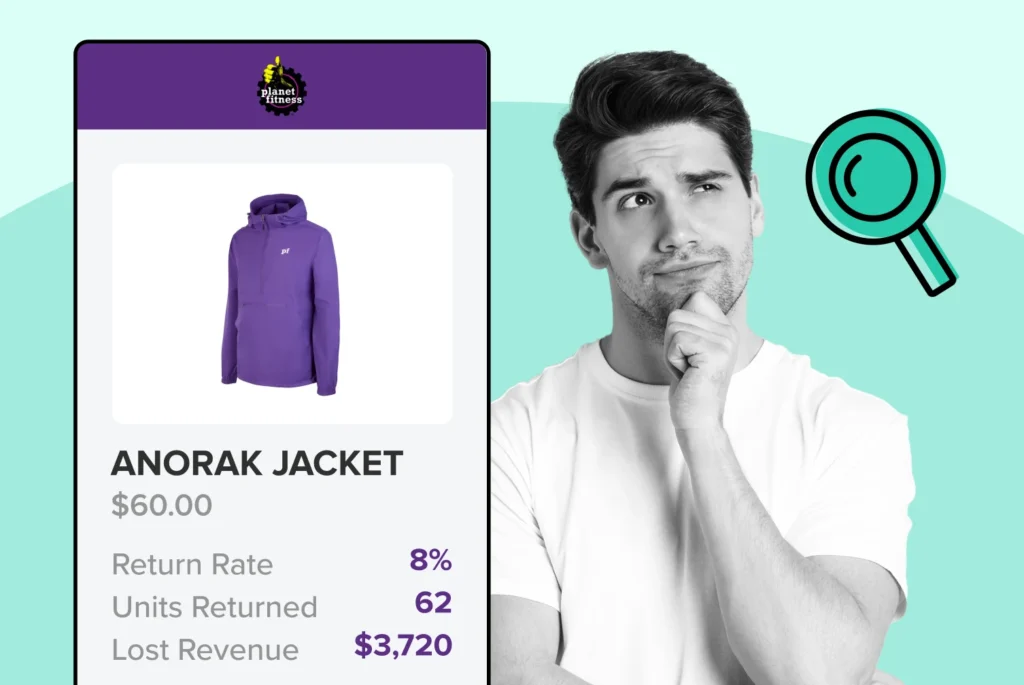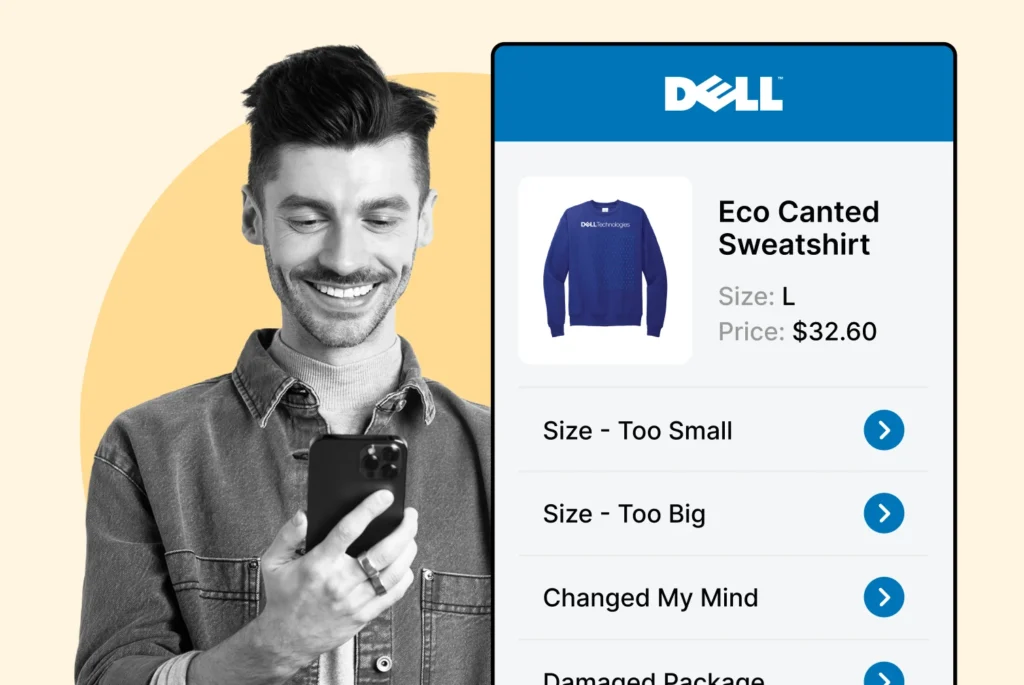
Essential Return Metrics for Shopify Merchants to Master in 2024
Explore crucial data that will directly inform your strategy and operations: return rate, average return value, and customer refund patterns!
Boost customer experience and reduce support tickets
Realtime order and shipment tracking
Proactive order and shipping notifications
Predictive pre-purchase estimated delivery dates
Self-Serivce branded order tracking
Effortless experience delivered
Make returns profitable and delight customers
Flexibility to define any return destinations & conditions
Simplify returns for your customers and team
Incentivize exchanges over returns
Returns management made easy for your team
Understand why your customers are returning
Unify the online and the in-store experience
Hassle-free pickup experience for customers
In-Store Dashboard to keep operations streamlined
In-Store and Online orders unified
Drive foot-traffic to your stores
Boost customer experience and reduce support tickets
Realtime order and shipment tracking
Proactive order and shipping notifications
Predictive pre-purchase estimated delivery dates
Self-Serivce branded order tracking
Effortless experience delivered
Make returns profitable and delight customers
Flexibility to define any return destinations & conditions
Simplify returns for your customers and team
Incentivize exchanges over returns
Returns management made easy for your team
Understand why your customers are returning
Unify the online and the in-store experience
Hassle-free pickup experience for customers
In-Store Dashboard to keep operations streamlined
In-Store and Online orders unified
Drive foot-traffic to your stores
Find the answer to all your questions
Explore the most comon questions about WeSupply
Calculate the ROI that WeSupply can bring you
Request a no strings attached review of your current shopping experience and missed conversion opportunities
Take a step by step trip through our functionality to see how we can improve your ecommerce processes.
Read actionable articles on how to optimize your post-purchase experience and decrease support tickets
Get inspired by stories of how our customers implemented an effortless post-purchase experience
A Deep Dive into Top Companies' Order Tracking & Returns Strategy
Wondering if WeSupply is a good fit for you? Read through our use cases to see how we can help you increase conversion & improve CX!

Retailers today grapple with return fraud as it threatens profit and erodes trust. This guide offers a realistic approach to preventing return fraud, emphasizing the importance of detecting return fraud and presenting tactics to identify and prevent fraudulent activities before they impact your business. Learn to discern between fraudulent and legitimate returns and enforce preventive measures effectively.
Return fraud is a significant and growing issue for retailers, especially in e-commerce, with various forms such as ‘wardrobing’, ‘bricking’, and using stolen cards to make fraudulent returns for cash.
The financial impact of return fraud on retailers is substantial, with an estimated $101 billion lost in 2023 due to such activities, leading to direct financial losses, operational disruptions, and negative effects on brand reputation.
Retailers are countering return fraud with a combination of improved return policies, advanced technology for fraud detection, and balance in customer service to prevent abuse while maintaining customer satisfaction.
WeSupply combats return fraud in retail by enforcing strict return policies and using technology to detect fraudulent activities. Its tools, such as no returns on sale items and automated fraud detection, help maintain operational efficiency and customer satisfaction. WeSupply also offers innovative refund options like store credits and gift cards to enhance customer loyalty. Interested in securing your returns process? Get started with WeSupply for a streamlined and secure
Return fraud is a nefarious practice where consumers exploit return policies, often by sending back different items than purchased, returning stolen products, or claiming items weren’t received when they were. In an era where online shopping is increasingly popular, the incidence of return fraud is on the rise. The deceitful practices individuals employ to illegitimately gain money or goods are a significant concern for e-commerce.
From receipt fraud to refund fraud, and from chargeback fraud to fraudulent transactions, retailers must stay vigilant to detect return fraud and protect their businesses.
Return fraud can take on various forms, making it a complex problem to tackle. Some common manifestations of return fraud include:
Customers returning empty boxes
Using receipts found in the trash to return stolen goods for credit
Shady practices such as ‘credit laundering’, where products are purchased with stolen or fraudulently obtained gift cards or store credit and then returned for a refund to a different card
These are just a few examples of the many ways in which return fraud can occur. It is important for businesses to be aware of these tactics and take steps to prevent them.
However, not all questionable return behaviors are fraud; some are considered abuse rather than fraud. For instance, ‘bracketing’, where multiple sizes or colors of an item are purchased with the intent of returning the unwanted ones, and ‘wardrobing’, where items are used before being returned, are considered return abuse. The distinction might seem subtle, but understanding these nuances is crucial in effectively addressing return fraud.
The increased prevalence of return fraud in the e-commerce industry is forcing online retailers to adjust their return policies and add measures to combat such activities. With the rise of online shopping, e-commerce businesses face unique challenges. High return rates not only introduce operational complexities but also increase costs due to fraudulent returns.
Addressing return fraud in e-commerce is of paramount importance, as it is not only about reducing financial losses but also about maintaining customer trust. Return fraud can damage a business’s reputation and customer trust, especially if return policies are tightened to combat fraudulent activities. Therefore, the challenge lies in striking a balance between combating return fraud and ensuring a smooth shopping experience for genuine customers.
Return fraud is a chameleon of a problem, constantly changing its appearance. It ranges from honest mistakes by shoppers to large-scale operations by organized crime rings. To combat it effectively, we need to understand its various facets and know the difference between return fraud and return abuse.
Return fraud, also known as return abuse, involves a shopper misusing a merchant’s return policy for personal gain or to harm the retailer. This can manifest in myriad ways, such as:
returning items that are different
returning counterfeit items
returning stolen items
returning items bought from another retailer at a lower cost
On the other hand, return abuse is a different beast. It is not always fraudulent but can still harm retailers, especially when it involves stolen or counterfeit items. It includes practices like purchasing multiple items with the intent to return some, using products before returning them, or returning obsolete items. Retailers are now beginning to ban consumers who frequently return items, known as serial returners.
Understanding these distinct behaviors is a crucial step in addressing the broader issue of return fraud.
Return fraud can come in many forms, each with its unique characteristics and challenges. Let’s delve deeper into eleven types of return fraud.
First, there’s ‘wardrobing’ and ‘free renting’, where customers purchase items with the intention of using them temporarily and then returning them. Then we have ‘opportunistic returns’ and ‘buyer’s remorse’, where customers return items due to impatience with delivery times, price switching, or after finding the same item at a lower price elsewhere.
The list doesn’t end there. We also have:
‘Seller sabotage’, where competitors deplete a seller’s inventory through returns to cause financial harm.
‘Bricking’, which involves returning electronics after removing valuable parts, then selling the parts and also claiming a refund.
‘Empty box fraud’
‘Stolen merchandise return fraud’
‘Cross-retailer return’
‘Employee return fraud’
‘Receipt fraud’
Recognizing these various types of return fraud is essential in developing effective prevention measures.
Return fraud is not a victimless crime. It has far-reaching consequences that extend beyond the immediate financial losses. It affects retailers, consumers, and the entire retail industry.
Retailers bear the immediate brunt of return fraud. They face direct financial losses, wasted time, shipping costs, administrative fees, and negative effects on brand reputation and customer loyalty. In 2023, U.S. merchants lost approximately $101 billion due to return abuse and fraud, with 5% of sales being returned and 7% of those returns identified as fraudulent or abusive, according to the National Retail Federation.
The effects of return fraud on retailers are not just immediate but can also have long-term impacts. It can lead to damage to brand reputation, decreased employee morale, and erosion of customer trust. Moreover, during the holiday seasons, return fraud escalates due to increased shopping activity and a rise in purchases made with the intention of returning them later.
While return fraud can be detrimental to retailers, the perpetrators often face minimal legal consequences. Return fraud is challenging to prove and prosecute, especially when not committed on a large scale. Fraudsters can face fines, penalties, and bans from stores if caught, but these consequences are not always enforced, leading to minimal repercussions for committing return fraud.
However, when caught and prosecuted, the penalties can be severe, depending on the value of the property involved in return fraud. When the property’s value exceeds $950, return fraud can be elevated to a felony charge, potentially leading to 3 years in prison and fines up to $10,000. Despite this, the difficulty in catching and prosecuting these fraudsters often leads to a lack of deterrence.
While the retailers and fraudsters often take center stage in discussions about return fraud, there’s another set of victims that often get overlooked – the owners of stolen cards. When their card details are used for return fraud, these individuals often endure financial distress and go through a strenuous chargeback process to recover their funds.
Victims of card theft can experience a challenging chargeback process to dispute the fraudulent transactions. In addition, they can face financial distress, especially if the unauthorized purchases cause their accounts to become overdrawn. Therefore, while return fraud might seem like a victimless crime from a distance, it has far-reaching consequences that affect more than just the retailers.
Preventing return fraud requires a well-thought-out strategy. It involves:
Implementing a clear return policy
Using secure online return portals
Employing digital tracking
Leveraging advanced tools to detect unusual return behavior.
Let’s delve into some of these preventive measures and best practices.
Establishing a solid returns policy with clearly communicated eligibility criteria and return merchandise authorization documentation requirements can reduce ambiguities and disputes. Having a firm returns policy that explicitly states the rules, timelines, and required documentation for returns can deter fraud.
However, it’s not just about having a policy but also about enforcing it. Fraudsters often start refund fraud by impersonating customers via communication channels. Therefore, businesses need to train their staff to verify identities before processing refunds or returns. This is an essential step in establishing effective return policies and tackling return fraud.
Create custom return policies
Book a quick call with our experts to see how WeSupply can help you take control of returns by creating custom policies to handle them all easily. You get to decide how you want to handle final sale items, return window lengths, return request approvals, and more.
WeSupply’s Pre-built Return Policies provide businesses with a robust framework to establish effective return policies, ensuring a balance between customer service and operational efficiency. These policies enhance profitability and maintain high standards of product quality. Here are the key features:
No Returns on Sale Items: Ensures items bought on sale are not eligible for return, balancing profitability and customer expectations.
Shipping Fee Based on Return Reason: Charges shipping fees for returns depending on the reason, balancing cost management with customer service.
Non-Returnable Personalized Products: Prohibits returns on personalized items to enhance inventory management and reduce losses.
Specific Non-Returnable SKUs: Improves inventory control by designating certain SKUs as non-returnable, aligning product strategy with return policies.
No Returns on Used Products: Ensures used items are non-returnable to enhance product quality control and ensure customer satisfaction.
Additionally, WeSupply’s Pre-Built Policies offer an effective way to manage fraudulent returns. By utilizing blocklisting of email addresses or customer groups, businesses can prevent known fraudulent customers from returning products, thereby safeguarding their interests and preserving revenue. This proactive approach ensures a more secure and efficient returns process, benefiting both the company and its legitimate customers.
With WeSupply’s Pre-built Return Policies, streamline your return process and protect your bottom line effortlessly. Ready to see how it works? Book a demo today and take the first step towards optimizing your return management!
In our digital age, technology plays a crucial role in combating return fraud. Digital tools like CRM software or dedicated fraud detection solutions can help quickly identify suspicious return patterns. They provide real-time data sync and comprehensive oversight of product returns, enhancing transaction legitimacy.
Moreover, advancements in technology have led to the development of new fraud detection tools. These tools can help businesses identify unusual refund patterns and behaviors that may indicate fraudulent activities. As return fraud tactics continue to evolve, the role of technology in fraud detection and prevention becomes increasingly essential.
WeSupply’s Automated Returns Management system enhances your return policies by effectively reducing return fraud, ensuring only genuine returns are processed. This smart system identifies potential abusers by analyzing patterns in return behavior, protecting your business from losses associated with fraudulent returns. Here are the key benefits:
Automatic Detection of Policy Abusers: Smart technology to detect and block fraudulent return attempts.
Customizable Detection Settings: Configure the system to recognize abusers and determine the appropriate actions.
Protection Against Refunds on Non-Returnable Items: Ensures non-returnable items are not mistakenly refunded.
Returns Analytics: Offers deep insights into the reasons behind returns, identifies patterns among serial returners, and provides data to help reduce the overall return rate.
This comprehensive management tool not only safeguards against return fraud but also enhances your understanding of customer behavior, helping you refine your return processes.
If your eCommerce store is running on the Magento 2 platform, you can check out the awesome WeltPixel MaxMind Fraud Prevention extension, which is designed specifically to bring MaxMind’s (one of the leading Fraud Prevention services in the eCommerce space) services over to the Magento 2 platform. The extension is officially endorsed by MaxMind and is one of the most powerful available on the market!
While combating return fraud is vital, it’s crucial to consider the legal and ethical implications of fraud prevention measures. Legal action against return fraud is generally considered a last resort due to the time and expense involved. Therefore, businesses must strike a balance between implementing measures to prevent fraud and ensuring they do not infringe on the rights of their customers.
On the ethical front, creating a positive work environment and a corporate culture that emphasizes clear organizational structure, written policies, and fair employment practices can play a significant role in deterring employee fraud. Businesses need to ensure they maintain high ethical standards in their fight against return fraud.
As fraudsters devise more sophisticated tactics, businesses, too, need to step up their game. Let’s delve into some advanced strategies for combating return fraud.
In the fight against return fraud, verifying the identity of customers during the return process is a crucial defense. Retailers can deploy identity verification platforms that confirm customer details like:
Name
Address
Date of birth
Phone numbers
ID numbers
This enhances transaction legitimacy for legitimate customers by utilizing transaction data.
Some identity verification systems even offer the ability to check identification documents and compare selfies to document photos to ensure the physical presence of the actual customer. This not only confirms the authenticity of the individual but also the legitimacy of the transaction, adding an extra layer of security in the return process.
Rethinking refund policies can also deter fraudulent returns. Some retailers are modifying their refund policies to offer store credit instead of a full refund in cash. Offering refunds in the form of credit can have multiple benefits.
There are several benefits to implementing a store credit refund policy:
It discourages fraudulent returns, as the fraudsters cannot gain any financial benefit if the refund is in store credit.
It can encourage customers to return to the store for future purchases, boosting customer loyalty.
It has the potential to increase sales, as customers may use their store credit to make additional purchases.
Rethinking refund policies can be a smart strategy in combating fraudulent refunds and return fraud.
WeSupply empowers businesses to transform their refund strategies from cash refunds to more engaging alternatives like store credits, gift cards, and coupon codes. This approach not only encourages repeat business but also fosters a stronger bond with customers. Here’s how WeSupply can enhance your refund policy:
Coupon Code Issuance: Engages customers by providing instant coupon codes for future purchases.
Gift Card Issuance: Delivers gift cards automatically, encouraging further engagement.
Return fraud is not just a nuisance for retailers; it comes with a hefty price tag. It’s essential to understand the cost of return fraud to grasp the severity of this issue.
The financial losses due to return fraud are staggering. In 2023, U.S. merchants lost approximately $101 billion due to return abuse and fraud. Here are some key statistics:
5% of sales were returned
7% of those returns were identified as fraudulent or abusive
For every $100 in accepted returns, retailers lost $10.30 to fraud in 2020, an increase from $8.80 in 2019.
In addition to the direct financial losses, return fraud also leads to operational disruptions. These include challenges in inventory management, lowered employee morale, and erosion of customer trust. Therefore, the cost of return fraud extends beyond immediate financial losses and can have significant long-term impacts on a business.
While combating return fraud is vital, it’s equally important to ensure that genuine customers are not affected in the process. Retailers need to balance strict fraud prevention measures with maintaining customer satisfaction. One way to do this is by creating rewards and incentive programs for genuine shoppers, which can enhance customer loyalty while deterring fraud.
Retailers should also strive to provide a seamless return experience for customers. This includes maintaining consistent communication throughout the return process and personalizing the returns experience for customers. By striking this balance, businesses can minimize losses due to return fraud without sacrificing customer satisfaction.
WeSupply offers innovative strategies to minimize losses while enhancing customer satisfaction through a comprehensive returns management system. By integrating a branded returns portal, WeSupply boosts customer loyalty by providing a seamless, branded experience rather than directing them to generic third-party sites. Key features include:
Flexible Returns Rules: Tailors return policies to fit various scenarios, ensuring a hassle-free experience for both customers and businesses.
Autogenerated QR Code Return Labels: Simplifies the return process with easy-to-use QR codes, eliminating the need for printing.
Proactive Returns Tracking and Notifications: Keeps customers informed with automatic updates via email and SMS, reducing the need for customer inquiries.
These tools not only streamline the returns process but also maintain high levels of customer engagement and satisfaction. Ready to enhance your returns strategy? Book a demo with WeSupply and discover how to transform your approach to returns.
WeSupply’s holistic approach not only reduces operational overhead but also drives customer retention by creating a positive post-purchase experience. By leveraging WeSupply’s branded returns portal, companies can significantly increase their return on investment (ROI) through reduced costs and enhanced customer loyalty. The system’s efficiency in managing returns cuts down on unnecessary expenses and optimizes resource allocation, leading to a more streamlined operation. To see just how much your company can save, try our ROI Calculator today.
As we look to the future, new trends and innovations in return fraud prevention are emerging. From predictive analytics to legislative changes, the landscape of return fraud prevention is continuously evolving.
The landscape of e-commerce security is in a constant state of flux. With increased digitalization, there are higher customer expectations and more severe impact when businesses fail to keep up. However, e-commerce also brings unique challenges.
Some of the challenges include:
The rising adoption of online shopping has resulted in an increase of personal and financial data on e-commerce websites, expanding the attack surface for cybercriminals.
The need to protect customer data and ensure secure transactions.
The constant evolution of new threats and attack techniques.
It is crucial for e-commerce businesses to stay updated with the latest security measures and technologies to protect themselves and their customers from cyber threats.
To adapt to these changes, e-commerce businesses need to:
Stay informed and continuously learn
Adapt to emerging trends in return fraud prevention to effectively address future challenges
Utilize technologies like artificial intelligence and machine learning for real-time transaction monitoring and anomaly detection.
In the fight against return fraud, predictive analytics and artificial intelligence (AI) are powerful weapons. Predictive analytics leverages historical and current data to predict future events, employing statistical modeling, data mining, and machine learning algorithms to identify patterns that suggest fraudulent activities.
AI, on the other hand, can enhance retailers’ ability to detect unusual behavior indicative of return fraud. By using these advanced technologies, businesses can enhance their fraud detection capabilities and stay one step ahead of fraudsters.
Legislative and industry changes are also shaping return policies and influencing return fraud prevention strategies. Various federal and state laws dictate the return policies retailers must adhere to and the rights of consumers in returning merchandise. These laws can influence the tactics retailers employ to prevent return fraud.
In addition to these legislative changes, industry changes are also shaping return policies. With the advent of new payment methods like digital wallets and cryptocurrencies, retailers need to adapt their return policies to accommodate these changes. These legislative and industry changes represent an evolving landscape that retailers must navigate in their fight against return fraud.
Through this exploration of return fraud, we’ve seen the many faces of this costly problem, the substantial impact it has on retailers and consumers, and the various strategies employed to combat it. As the retail landscape evolves, so do the tactics of fraudsters. Therefore, businesses must stay vigilant, continuously innovate, and adapt their strategies to effectively safeguard their operations.
Remember, the fight against return fraud is not a one-time battle but a continuous journey.
Return fraud is a complex and costly issue that affects retailers and consumers alike. It takes on various forms and has far-reaching consequences. However, by understanding its various facets, implementing effective return policies, leveraging technology, and continuously adapting to evolving trends, businesses can effectively combat return fraud. The journey may be challenging, but with diligence and innovation, businesses can protect their operations and maintain customer satisfaction.
WeSupply offers a comprehensive suite of tools that effectively tackle return fraud in retail, ensuring a harmonious balance between customer satisfaction and operational efficiency. Through its Pre-built Return Policies, WeSupply establishes strict guidelines like no returns on sale items and personalized products, significantly reducing opportunities for fraud. Additionally, the Automated Returns Management system uses smart technology to detect and prevent fraudulent activities by analyzing return patterns and integrating block lists. This not only minimizes losses but also provides deep insights into customer return behaviors, allowing for better strategy formulation.
Moreover, WeSupply’s approach to transforming refund processes into more engaging methods like store credits, gift cards, and coupon codes further secures the retailer’s interests while enhancing customer loyalty. Combined with self-service returns, flexible rules, and proactive tracking notifications, WeSupply provides a robust framework for preventing return fraud and streamlining the returns process. Ready to secure your returns and enhance customer trust? Get started with WeSupply and revolutionize your return management strategies.
Speed up returns process
Book a quick call with our experts to see how WeSupply’s self-service returns makes it super easy for your customers to return anything, anytime – without needing to submit customer support tickets or call in!
Return fraud is when consumers take advantage of return policies to benefit themselves or harm the retailer, such as by returning items that are counterfeit or stolen. It’s a deceptive practice that can have negative impacts on businesses.
The main difference between return fraud and return abuse is that return fraud involves deceitful practices for personal gain or to harm the retailer, while return abuse, while not always fraudulent, can still harm retailers. Both involve misuse of a retailer’s return policy.
WeSupply utilizes a combination of Pre-built Return Policies and an Automated Returns Management system to significantly reduce opportunities for return fraud. Strict guidelines are enforced, such as prohibiting returns on sale items, personalized products, and used goods, to minimize fraudulent returns.
WeSupply’s system automatically detects potential fraud by analyzing return behavior patterns. It incorporates smart technology to block known abusers and integrates seamlessly with existing block lists, ensuring that only genuine returns are processed.
To discourage fraudulent returns and encourage legitimate customer engagement, WeSupply offers refunds in the form of store credits, gift cards, and coupon codes instead of traditional cash refunds.
Yes, WeSupply does have an official Shopify App. You can download and begin to integrate it with your Shopify store.
Yes, WeSupply has an official extension for Magento. The WeSupply x Magento integration allows for automating order tracking experiences, reducing customer inquiries, automating shipping email and SMS notifications, and providing a fully branded order tracking experience
Yes, WeSupply has an official BigCommerce App. You can integrate WeSupply with your BigCommerce store to improve your post-purchase customer experience.

Learn How To Create Successful Post Purchase Email Campaigns
Build an effective post-purchase email flow that helps you increase customer satisfaction and drive revenue growth!
Consumers seek the best deals on:

Explore crucial data that will directly inform your strategy and operations: return rate, average return value, and customer refund patterns!

Let’s dive into innovative approaches that equip you with actionable insights on harnessing the full potential of returns data!

How you can leverage the different return metrics to fine-tune your business strategy and drive sustainable growth!

Concrete strategies for preventing ecommerce return fraud: from strengthening your return policy to leveraging technology and analytics!

Practical strategies and real-world applications to turn your returns into a powerful operational efficiency and customer satisfaction tool!

Let’s explore the tangible impact of retail analytics, revealing how it informs strategies, optimizes operations, and predicts market trends!

Discover how to tackle this complex aspect of online selling and let returns add value to your Shopify store rather than subtract from it!

Minimize returns and cultivate customer loyalty! Let’s explore how a return analytics dashboard can be critical to your business’s success!

Learn how analyzing returns data sharpens product development, directing you toward a more successful eCommerce future!